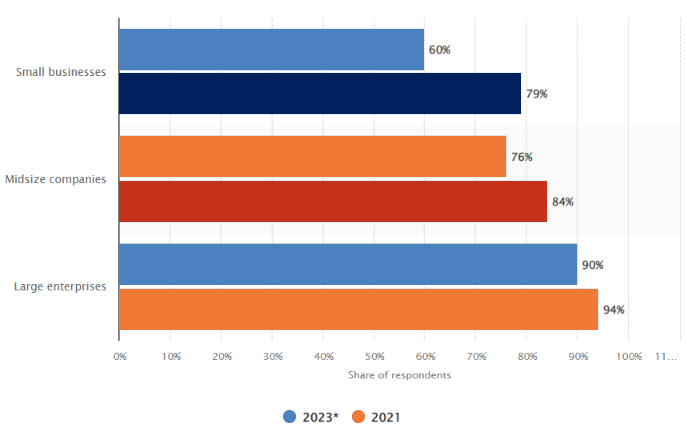
Mar 22, 2024
The cloud revolutionized how businesses operate, shattering the limitations of on-premises infrastructure. However, the one-size-fits-all approach is fading fast. Businesses today require the flexibility to adapt and innovate, and that’s where the power of multi-cloud comes in.
A multi-cloud strategy allows you to leverage the best of multiple cloud providers, unlocking a world of agility, scalability, and cost-efficiency. This guide, designed for business owners, IT leaders, and decision-makers, equips you with the knowledge to navigate the multi-cloud landscape.
Whether you’re just starting or refining your strategy, this roadmap will empower you to make informed decisions and unlock the full potential of multi-cloud. However, navigating this complex landscape can be challenging. Fear not– cloud consulting services can provide invaluable expertise to help you craft a winning multi-cloud strategy tailored to your specific needs.
This blog will explore the benefits and challenges of adopting a multi-cloud strategy.
What is multi-cloud?
Imagine having access to a variety of specialized tools instead of just one toolbox. Multi-cloud is like that for your technology needs. It involves using multiple cloud service providers (CSPs) to create a custom cloud environment that perfectly fits your specific requirements.
Cloud adoption soars across businesses of all sizes
The way businesses leverage cloud computing is undergoing a massive shift. Single-cloud strategies are giving way to a multi-cloud approach, with companies embracing the benefits of utilizing multiple Infrastructure-as-a-Service (IaaS) providers.
Here’s a breakdown of this trend by organization size:
- Large enterprises: By 2021, a staggering 90% companies had adopted a multi-cloud strategy, and this dominance is expected to climb even higher, reaching 94% by 2023.
- Mid-sized companies: Following closely behind, over three-quarters (76%) of mid-sized businesses are already on board with multi-cloud, with that number projected to increase to 84% by 2023.
- Small businesses: The trend isn’t limited to larger players. A surprising majority (60%) of small businesses have already adopted a multi-cloud approach, and this figure is poised for a significant jump, reaching an estimated 79% by 2023.
This data paints a clear picture: multi-cloud is the future of cloud computing, with businesses of all sizes recognizing its advantages.
Source: Statista
What is a multi-cloud strategy?
The multi-cloud landscape is brimming with potential, offering businesses a wealth of flexibility, enhanced security, and significant cost-saving opportunities. However, venturing into this domain without a well-defined plan is like setting sail on a vast ocean without a compass. Here’s where a multi-cloud strategy becomes your guiding force.
A meticulously crafted multi-cloud strategy acts as your roadmap to cloud success. It eliminates guesswork by clearly outlining the specific cloud services you’ll leverage (public, private, or a strategic hybrid approach) and the vendors you’ll partner with. This clarity ensures your cloud journey aligns perfectly with your business objectives and steers you towards optimal IT solutions that meet your unique needs.
But a multi-cloud strategy goes beyond simply picking cloud providers. It’s about crafting the ideal cloud mix – a strategic selection of services that delivers a lean and efficient cloud environment. This translates to maximized performance while keeping unnecessary expenses at bay. By understanding how this “cloud mix” factors into your overall strategy, you can ensure your business operations and IT infrastructure become leaner and more efficient.
Benefits of a multi-cloud approach
- Flexibility: You have the freedom to choose the best services from different providers. Need top-notch data storage? Choose a provider known for that. Need powerful computing for complex tasks? Pick a provider that excels in that area.
- Avoid vendor lock-in: By relying on multiple providers, you’re not stuck with one company. This gives you more negotiating power for pricing and allows you to adapt to new technologies and services that emerge in the future.
- Cost savings: With multiple providers competing for your business, you can leverage this to your advantage. Compare pricing models and choose the most cost-effective options for your specific needs.
- Disaster recovery: If one cloud provider experiences an outage, your entire operation doesn’t have to come to a standstill. By spreading your data and applications across multiple platforms, you ensure business continuity and minimize disruption.
- Enhanced security: Security is paramount. A multi-cloud strategy allows you to implement different security measures from various providers, creating a more robust defense system for your data.

Cloud strategy and assessment workshop
The adoption of cloud-based infrastructure by enterprises is increasing greatly. However, a lot of enterprises are still reluctant to adopt a cloud strategy due to lack of skills or knowledge.
Challenges of multi-cloud
While multi-cloud offers significant advantages, it’s not without its complexities:
- Management: Juggling multiple cloud environments can be tricky. Consider using a central management platform to simplify the process and keep everything organized.
- Data consistency: Ensuring your data remains consistent across different cloud platforms is crucial. Look for solutions that can help you integrate your data seamlessly.
- Security: Security needs to be consistent across all your cloud platforms. Work with your providers to ensure they offer robust security features and that your overall security posture is strong.
Choosing the right cloud providers
With a vast array of cloud providers available, selecting the perfect partners can feel overwhelming. Here are some key considerations:
- Identify your needs: Every business has unique requirements. What kind of storage do you need? How much processing power? What security features are most important? Clearly define your needs before selecting providers.
- Focus on security: Choose providers with a proven track record of robust security practices and that meet your compliance requirements. Security should never be an afterthought.
- Scalability matters: Your business will grow and evolve. Select cloud providers who can scale seamlessly alongside your growth, ensuring your infrastructure can handle increasing demands.
- Partner with an expert: Consider working with a trusted advisor who has experience with multi-cloud implementations. They can guide you through the process, answer your questions, and help you navigate any challenges that arise.
Suggested: How to choose the right cloud consulting partner?
Real-life use cases of multi-cloud approach
1. Netflix: the multi-cloud maestro of streaming
Imagine flawlessly streaming your favorite show without buffering, even during peak hours. That’s the magic of Netflix’s multi-cloud strategy. To deliver content globally and ensure high availability, Netflix utilizes a hybrid cloud approach. Their public cloud stores the massive content library and user preferences. But for extra flexibility and reduced latency, they’ve built their own private cloud. This private cloud seamlessly integrates with the public cloud, allowing them to deliver video content directly from their servers.
The power of multi-cloud goes beyond just content delivery. Here’s where data analytics comes in: Netflix leverages a multi-cloud environment to analyze vast amounts of user data across various cloud platforms. This data includes viewing habits, search preferences, and device usage.
2. Airbnb: balancing scalability and security with multi-cloud
Airbnb thrives on a multi-cloud strategy that optimizes both scalability and security for its massive user base. They strategically selected a public cloud for storage, databases, website operations, and analytics. This allows them to leverage the public cloud’s elasticity to handle spikes in demand during peak travel seasons. Additionally, they’ve integrated a private cloud to securely store users’ sensitive personal information. This two-pronged approach ensures both scalability for their ever-growing business and robust security for user data.
3. Scottish government: A multi-cloud champion for rural prosperity
The Scottish Government’s Agriculture and Rural Economy Directorate (ARE) plays a vital role in supporting Scottish agriculture through subsidies and other initiatives. To streamline operations, secure data, and proactively address potential threats, they implemented a multi-cloud strategy. This allows them to scale their services as user demands fluctuate and remain cost-effective. Their multi-cloud solution translates to secure, uninterrupted services for farmers and other stakeholders, fostering continued growth in the rural economy.
Embrace the future of multi-cloud with Softweb Solutions
By implementing a well-defined multi-cloud strategy, you can open the door to many possibilities for your business. Increased agility, enhanced security, and significant cost savings are just a few of the rewards that await you.
Remember, the key lies in understanding your needs, selecting the right cloud partners, and working with a trusted advisor to ensure a smooth and successful multi-cloud journey. Softweb Solutions can be your partner in this endeavor. We have the expertise and experience to help you craft a winning multi-cloud strategy and ensure a successful implementation. Contact us today and let’s get started!
AI Workshop
Envision how your AI Journey can be in next 1-3 years from adoption and acceleration perspective.
Enroll NowNeed Help ?
We are here for you
